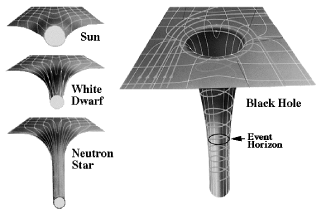The Anatomy of Black Holes - Page 11
IV. Activities and Problems Related to Black Holes
This demonstration allows for a visual depiction of the effect of a large mass on the fabric of spacetime. In particular, what effect a black hole does or does not have on the other stars around it and how that effect depends on the mass of the black hole. Remember that Newton saw objects with increasing mass as having an increasing escape velocity; Einstein saw them as making deeper "dents" in the fabric of spacetime!

A black hole makes such a deep "dent" that it forms a bottomless well. The sides of the well are so steep that even light cannot escape once it has fallen deeper into the well than the event horizon depth.
Materials:
- Round bowl, roughly 10 cm in diameter
- Tape
- Package of small round beads (such as you might find in the cake decorating section of grocery store)
- 3 cm solid ball bearing (the eraser end of a pencil can be used as a replacement)
- Latext Sheet
Procedure:
1. Tape the sheet of latex (this represents space-time) tightly across the top of some round object, such as a bowl or even a coffee cup. The sheet should not be so tight that it will tear if stretched further, but should be taut enough that there are not any wrinkles!
Note: This is much easier to do with the help of a partner!




